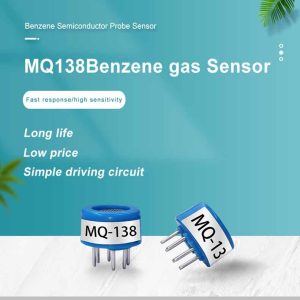Air pollution has become a pressing global concern, impacting human health, ecosystems, and climate change. To combat this issue effectively, accurate and real-time monitoring of air quality is essential. Gas sensors have emerged as powerful tools for measuring various pollutants in the atmosphere. In recent years, advancements in gas sensor technology have revolutionized air quality monitoring, enabling better understanding of pollution sources, improved public health interventions, and effective environmental management. This article explores the significance of gas sensors in enhancing air quality monitoring and highlights their potential benefits in addressing the challenges of air pollution.

The Importance of Air Quality Monitoring:
Air pollution poses severe risks to human health, contributing to respiratory illnesses, cardiovascular diseases, and other health complications. Monitoring air quality allows for early detection of elevated pollutant levels and the implementation of appropriate measures to mitigate health risks. Additionally, tracking air quality trends helps in identifying pollution sources, assessing the effectiveness of pollution control strategies, and developing targeted policies to reduce emissions and improve air quality standards.
Understanding Gas Sensors:
Gas sensors are electronic devices designed to detect and measure specific gases present in the atmosphere. These sensors operate on various principles, including electrochemical, metal oxide semiconductor, and optical sensing mechanisms. Gas sensors can detect a wide range of pollutants, such as nitrogen dioxide (NO2), ozone (O3), carbon monoxide (CO), sulfur dioxide (SO2), volatile organic compounds (VOCs), and particulate matter (PM). They provide real-time measurements of pollutant concentrations, enabling accurate assessment of air quality and timely response to pollution events.
Real-Time Monitoring of Pollutants:
Gas sensors facilitate real-time monitoring of pollutant levels, providing continuous data on air quality. Traditional air quality monitoring methods typically involve manual sampling and laboratory analysis, resulting in delayed measurements. In contrast, gas sensors offer instant and on-site measurements, allowing for immediate response to changing pollution conditions. Real-time monitoring helps identify pollution hotspots, evaluate the effectiveness of emission control measures, and facilitate timely interventions to protect public health and mitigate environmental impacts.
Early Warning Systems:
Gas sensors can act as early warning systems, providing alerts when pollutant levels exceed predefined thresholds. By integrating gas sensors into air quality monitoring networks, authorities can quickly notify the public and take preventive actions to minimize exposure to harmful pollutants. Early warnings enable individuals to adjust their activities, such as avoiding outdoor exercises during high pollution events or using appropriate protective equipment. Furthermore, gas sensors can be deployed in sensitive areas, such as schools and hospitals, to ensure the well-being of vulnerable populations.
Source Apportionment and Pollution Mapping:
Gas sensors help in identifying pollution sources and quantifying their contributions to overall air pollution. By strategically deploying gas sensors across different locations, spatial variations in pollutant levels can be mapped, enabling source apportionment studies. This information is valuable for policymakers and urban planners to develop targeted pollution control strategies, regulate emissions from specific sectors, and prioritize interventions in high-risk areas. Additionally, pollution mapping facilitates citizen engagement, empowering communities to take proactive measures in reducing pollution at the local level.
Integration with IoT and Big Data Analytics:
Gas sensors can be integrated into Internet of Things (IoT) platforms, enabling the seamless collection and analysis of air quality data. By leveraging IoT technologies, gas sensor networks can transmit real-time data to centralized databases, facilitating comprehensive air quality assessments. Big data analytics can further process and analyze the collected data, unveiling hidden patterns and correlations between pollutant levels, meteorological conditions, and human activities. These insights provide a deeper understanding of air pollution dynamics, supporting evidence-based decision-making for pollution control strategies.

Conclusion:
Gas sensors play a pivotal role in enhancing air quality monitoring efforts. Their ability to provide real-time measurements, act as early warning systems, identify pollution sources, and facilitate data-driven decision-making makes them invaluable tools in combating air pollution. By harnessing the power of gas sensors, authorities, researchers, and communities can work together to implement effective pollution control measures, protect public health, and ensure a sustai
 : +86 155 8830 2704
: +86 155 8830 2704 : jxdziot@gmail.com
: jxdziot@gmail.com
